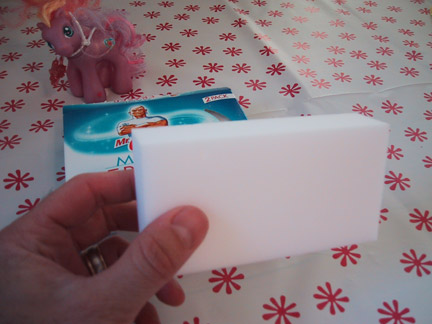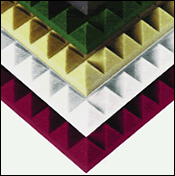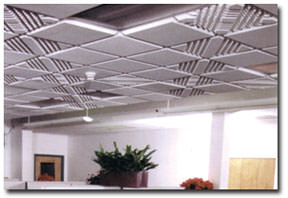
The original Magic Eraser, out of the box, before being put through a trial -- and performing beautifully!
(This and other photos of how it performed at Michael P's blog of Cruft)
My kitchen sink is an old enamel thing and it stains really easily. Press a pan against it and voila, there are a bunch of steel-colored scrapes all over it. Leave a glass in the sink with water in it for a day and it leaves a ring. Even though these stains show up very easily, often even bleach doesn't get them out. With the Magic Eraser, though, they come off with hardly any effort. Miraculous.
Same story in the shower. Wipe it on the floor and the water stains come right off. It cleans gunk off the side of pans that regular soap & a dishcloth can't budge. It cleans out the bathroom sink easy as pie. It works so well and so easily, I was very curious to know how it does what it does so well. At the same time, I was afraid to find out that I was using something toxic or wrong or in some way bad. So I restrained my curiosity and did not look into it. Until today.
I am very relieved to know, the Magic Eraser is not bad.

I like the Extra Power variety. The curvy sides make it easier to hang onto. It's also supposed to work 50% better than the regular sort, but I haven't done a one-on-one comparison, so I can't attest to that.
- The major ingredient in there is a melamine foam. First, let's talk about the foam part.
- Some foams are pockets of air or another gas trapped in a liquid. Dishwashing liquid foam, is one example, or shampoo foam, or spray-can shaving cream.
- Other foams can be air or gas bubbles trapped in a solid. Styrofoam is one example here. Foam padding that people use as mattresses is another.
- The Magic Eraser is the second kind -- air pockets that form in a solid.
- The foam is made when melamine resin is cured -- hardened, essentially. The resin (a plastic) gets a bunch of air bubbles in it, and it hardens that way. Also, the resin gets very thin but very hard, like a needle-sharp piece of glass.
- So you've got all these air bubbles surrounded by very strong net of glass-like stuff. But it's not brittle like glass. In fact, it's flexible like a sponge. It's hard to keep the idea of glass and sponge in your mind at the same time, but that's what's going on in there.

Diagram of the structure of the melamine foam in a Magic Eraser.
(Image from BASF. They also have an animation of how it works that's helpful.)
- There's one more thing that happens. Not all of the glass-like spongey bubbles stay intact. Some of them break. This makes the Magic Eraser what's called "open-cell" foam.
- Now, when you rub this substance over a surface -- say, over my kitchen sink -- the superfine yet super-hard resin scrapes away the stains. What's more, the stain or whatever goo it has scraped off gets collected in the bubbles that have broken open. The open cells become almost like miniature trash cans for the stains.
- Pretty ingenious, I say.
- The only downside is the Magic Erasers don't last very long. The fineness of the resin breaks down pretty quickly, and those open cells get filled up with the goo pretty fast. But they sure do the job, in my opinion. Many others agree.
- Also, if the material you want to clean is very sensitive to scratching, you probably don't want to use this. But all the surfaces I've tried it on have been fine.
So then I have to ask, what is melamine?
- First, I want to address an old rumor that Magic Erasers are toxic and stores have been pulling them from their shelves. Both parts of that rumor are not true.
- The reason people think they're toxic is because the full chemical name for the melamine foam is formaldehyde-melamine-sodium bisulfate copolymer. People see that word "formaldehyde" and they freak out.
- But as we all remember from our chemistry classes, when you mix substances together, their properties change. Hydrogen on its own is a gas, extremely flammable and dangerous. Pair it with oxygen, though, and you get water.
- Same thing happens with our Magic Eraser. Its manufacturers have combined formaldehyde with other substances to get an entirely different compound with entirely different properties.
- Melamine is a mixture of carbon, hydrogen, and nitrogen. It was first mixed in the 1830s and was used to make plastics and laminates.
- If you mix melamine again with formaldehyde, you get our friend the moldable plastic resin foam that's useful for all kinds of things.
- Melamine foams have been in use for decades in a variety of applications:
- Sound-proofing foam in airplanes, cars, ceiling tiles, acoustic sound rooms.
- Foam in cushions for mattresses and sofas.
- Flame-retardant in construction.
- Strengthener in other materials like Formica counter tops and dinnerware (though the plates scratched easily, and you can't get plates made with melamine foam anymore).

Melamine foam cut into pyramid shapes makes a great sound proofing material.
(Photo from ASI Pro Audio Acoustics)

Here is melamine foam in the form of acoustic, patterned ceiling tiles.
(Tiles available from Acoustical Surfaces, Inc.)
- You don't want to eat a Magic Eraser certainly. Melamine in powdered form is the stuff that got added to pet food and to infant formula in China and which killed or injured people's pets and children.
- I know some of you out there might love your Magic Eraser so much you want to eat it. But don't, okay?
- But as far as cleaning with it and handling it, you're fine. It's only toxic inside the body. I checked the Material Safety Data Sheet. These things exist for all chemicals. The manufacturers have to publish them, and they have to tell you if something is toxic or hazardous and they have to tell you if the stuff requires special handling. In brief, here's what it says for melamine foam:
- No hazardous ingredients.
- It can catch on fire, but its flash point is over 400 degrees Celsius. (That's 752 degrees F. This flash point is so high, the stuff is used as a fire retardant.)
- If it gets ground up into dust, "treat as any nuisance dust."
- That's it. So just don't eat your Magic Eraser, don't put it in your pet food, don't put it in your infant formula. Clean your counter tops and your stove tops and your sinks with it and throw it away when it looks beat, and that's it.

When your Magic Eraser starts looking grungy like the ones on the right, toss it.
(Photo posted at a billiards forum, by a member recommending its use in cleaning the shaft of pool cues.)
Sources
K. Caldwell, Magic Eraser by Mr. Clean: Product Review, Associated Content, June 27, 2006
Judy Stark, A hand for Mr. Clean, St. Petersburg Times, July 24, 2004
BASF, Science around us, Spring cleaning . . . as if by magic
Howstuffworks, Erasing Stains with Melamine Foam
Snopes.com, Mr. Clean Magic Erasers have been banned -- false
Wise Geek, What is Melamine?
Kate Pickert, Brief History of Melamine, Time, September 17, 2008
Acoustical Surfaces, Inc. Material Safety Data Sheet for Melamine Foam, issued July 1, 2003
Can I use it as a body scrub?
ReplyDeleteI'm glad I read this because I was just grating some up to feed to my baby! Seriously, it even gets crayon marks off of walls. I'm glad to know it's not toxic.
ReplyDeleteActually, there are lots of stories out there about kids and adults rubbing the Magic Eraser on their skin and getting burns or rashes. These are all urban legends -- a.k.a. lies. You can't get a chemical burn from these things.
ReplyDeleteAll the same, it is a household cleaning product, not a loofah. I would not recommend it as a body scrub. It wouldn't even work as well as a loofah.
When I worked at the Gap, no one ever cleaned out the clutter from our bathroom/storage room, so when I was in the bathroom I would always read this old Mr. Clean Magic Eraser box. This blog entry brought back good memories...
ReplyDeleteI agree totally! The Magic Eraser really does seem like magic and does a particularly good job on my stainless steel sink. Thanks for the description of how it works. www.satisfiedsole.com
ReplyDeleteI want one! I must go out and buy one. Hey, Daily Apple, any chance you'll blog soon about the exploding dye packs that bank tellers slip in with the cash when a bank gets held up? If so, could that be reprinted in a Northern California newspaper?
ReplyDeleteTim
Sure, Tim, you bet. Totally cool topic.
ReplyDeleteThis comment has been removed by the author.
ReplyDeleteI use it a lot to clean black marks off the corner of walls. It's great to see some back ground information.
ReplyDeleteI'd be curious to know if it can be used on car paint without damaging it. For instance, if you have stubborn bugs or if you drive through wet road paint, could it be used without damaging the original paint? I'm afraid to try, even in the door frame. Pittsburgh is in what's called the "rust belt" for a reason.
ReplyDeleteI'm certain that if you rubbed hard enough with a magic eraser to remove bugs and road paint from your vehicle that you would mar the paint job on your car. You should check with your local dealership for something that would remove both without damaging your paint or sealant coat.
DeleteI don't think a Magic Eraser would do anything to damage the car paint at all. But I also don't think it would do much to get rid of stuck-on bugs. You'd really have to apply a lot of pressure to get those off, and Magic Erasers are kind of fragile and sort of crumble in high-pressure situations, so to speak.
ReplyDeleteAs for removing a layer of new paint that you've driven through, I think you're going to need to go to the body shop for that one.
I love the magic eraser. I would marry it if I could. I cleaned my shower with it and it got rid of grime that has been there for 5 years, that no other harsh chemical could get rid of.
ReplyDeleteThanks for the info, it is really helpful. However, I'd bet the manufacturing process is pretty nasty, and pollutive. That said, the 'erasers' are fantastic when you really need them. As for bathtubs and porcelain sinks, Barkeeper's Friend is really fantastic, non-toxic (don't let your kid eat it) and muchly, much more cost effective.
ReplyDeleteBK'sF is also brilliant on cooking pots and other stainless steel.
ReplyDeleteYou're probably right about the manufacturing process. I have no doubt that Barkeeeper's Friend is especially handy. I still use another type of powdered cleanser with bleach (Comet) for the same reason. But is BK's F abrasive? That's one of the things these "erasers" have going for them is that they aren't abrasive.
ReplyDeleteFrom your description, "the superfine yet super-hard resin scrapes away the stains. "
DeleteDoesn't that mean they are abrasive?
these things are fantastic. i actually can get excited about cleaning with them, cause they remove the gunk that stick around forever. I don't use them daily, since they are not actually eco friendly, but for heavy duty jobs they are the best. I can't deal with toxic chemical cleaners. I've found them great to remove the gunk that discolors the tile grout in my kitchen and bathrooms. I get the generics in a box of 2 for $1 at the dollar tree. I think they work as well as the name brands.
ReplyDeleteOoh, good to know there are generic versions! Thanks for the tip.
ReplyDeleteThey have had these for years here in South Korea under the name (quite plainly) melamine foam. Apparently longer than the Mr. Clean version in the states. Quite interesting.
ReplyDeleteThe white sponge (magic eraser) is one of the best things invented since the wheel. However, contrary to the above, they can be abrasive to a shiny finish, i.e., glossy or semi-gloss paint, a porcelain stove top, etc. Suggest you work gently with them on such finishes or spot-test them in an area that's not visible. Bar Keeper's Friend is a good product, but I've found that BonAmi is even better. BonAmi is definitely non-abrasive, has a million uses, and is bio-degradable. Check out the web site. Remember too, Comet/Ajax is definitely abrasive and so is the bleach it contains. It will eventually remove the finish from sinks and the like. Pumice stones work well too and they won't damage porcelain. We own a commercial cleaning company and use all of the above products so we've had a great deal of practice!
ReplyDeleteI used the magic eraser on my walls and it left marks where I used it. Any suggestions on that problem? I do however, use them to remove the scuff marks from the ledge on the door in my car. It works great for that.
ReplyDeleteWe are painting as as prep, we washed the walls and ceiling. On the walls we used Simple Green on rags, but the ceiling was too high . So we went to Home Depot and they were selling Magic Eraser mops. I thought it would be great to reach the ceiling, so bought one. That's what we used, nothong else, no chemicals or cleaners with it. Just dipped the head in a bucket of hot water and ran it along the ceiling. It cleaned it well. But when we later applied the primer coat, it would not stick and the old paint started coming off, as if it was bubbled. Primer on the walls where we did not use the Magic Eraser mop were just fine, the primer went on and bonded with no problems. Now we have to sand the ceiling before primering and painting. I'm wondering if the Magic Eraser had anything to do with the paint bubbling on the ceiling? It just seems like it may have had something to do with it.
ReplyDelete